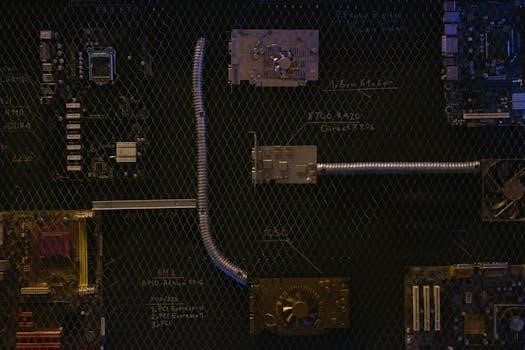1966 chevelle ignition coil wiring diagram pdf chev
Understanding the 1966 Chevelle Ignition System
The 1966 Chevelle’s ignition system is crucial for starting and running its engine. It relies on a traditional setup, using a coil to generate high voltage for spark plugs. This system, though not overly complex, requires careful understanding of its components for proper maintenance and troubleshooting.
Basic Components of the 1966 Chevelle Ignition
The ignition system of a 1966 Chevrolet Chevelle is composed of several key parts working in harmony. At the heart of it all, we have the ignition coil, which acts as a transformer, stepping up the battery’s 12 volts to the thousands of volts needed to create a spark. The distributor plays a critical role, ensuring each spark plug fires at the correct time to ensure proper combustion. Inside the distributor are mechanical points and a condenser, which together work to interrupt the low voltage circuit to the coil, thereby causing it to discharge its high voltage energy. The spark plugs, located in each cylinder, are where this high voltage energy creates a spark, igniting the air-fuel mixture. A wiring harness connects all the components, and it also includes a ballast resistor (or a resistance wire) in the primary circuit, which helps protect the contact points. The ignition switch provides the initial power to the system. Understanding each component, its function, and its relationship to the others is critical for any 1966 Chevelle owner.
The Role of the Ignition Coil
The ignition coil in a 1966 Chevrolet Chevelle is an essential component, acting as the heart of the ignition system. Its primary function is to convert the relatively low voltage from the car’s battery, typically around 12 volts, into the high voltage required to create a spark at the spark plugs. This high voltage spark is crucial for igniting the air-fuel mixture in the engine’s cylinders, initiating the combustion process that powers the vehicle. The coil achieves this through electromagnetic induction; it has two main windings, a primary winding and a secondary winding. When the circuit to the primary winding is interrupted, the collapsing magnetic field induces a very high voltage in the secondary winding. This high voltage is then sent to the distributor, which directs the energy to the appropriate spark plug. Without a functioning coil, the engine simply would not run. The coil must be correctly wired and in good condition to perform this critical task effectively, which is why understanding its role is so important.

Locating a 1966 Chevelle Ignition Coil Wiring Diagram
Finding an accurate wiring diagram for your 1966 Chevelle’s ignition coil is crucial for proper diagnosis and repair. These diagrams detail wire connections, ensuring correct system function and can be found from various reliable sources.
Sources for Wiring Diagrams
When seeking a 1966 Chevelle ignition coil wiring diagram, several reliable sources can provide accurate information. Firstly, consider the original manufacturer’s service manuals, often available through online retailers specializing in vintage automotive literature or from reputable car clubs that maintain archives. These manuals contain detailed diagrams specific to the 1966 Chevelle model year. Furthermore, various aftermarket repair manuals, such as those from Haynes or Chilton, often include wiring diagrams for classic vehicles, though it’s vital to verify that they cover the specific year and model.
Online forums and communities dedicated to classic Chevrolets are another valuable resource, where members frequently share scanned diagrams and technical tips. Websites specializing in automotive wiring diagrams may also offer downloadable PDFs or interactive diagrams. Always cross-reference diagrams from multiple sources to ensure accuracy, as variations can exist, especially in older vehicles that may have had modifications over time. When browsing online, prioritize sources known for their accuracy and reliability, as some may contain errors or incomplete information. Checking user reviews and community feedback can also help identify trustworthy sources for 1966 Chevelle wiring diagrams.
PDF Format Considerations
When dealing with 1966 Chevelle ignition coil wiring diagrams, the PDF format offers several advantages. PDFs are widely accessible across various devices, ensuring compatibility whether you are using a computer, tablet, or smartphone. This portability is beneficial for referencing the diagram while working on the vehicle. Furthermore, PDF files generally preserve the original formatting of the wiring diagram, including detailed lines, symbols, and text, unlike some image formats that might lose quality during resizing. This consistent presentation is crucial for accurate interpretation of the diagram, especially when identifying specific wires and connections within the ignition system.
The PDF format also allows for easy printing, ensuring you have a physical copy readily available in your workspace, if needed. Moreover, many PDF readers offer features like zooming, which enables a closer view of intricate sections of the diagram without any loss of clarity. This is especially useful when working with older schematics, where the details might be small or closely spaced. It’s important to ensure that the PDF is of high quality and not a low-resolution scan, which could make the diagram difficult to read. Always verify the diagram’s source to confirm its accuracy and completeness.

Analyzing the Wiring Diagram
Analyzing a 1966 Chevelle wiring diagram requires careful attention to detail. Understanding the schematic’s layout is crucial for tracing circuits and identifying individual wire functions. This process helps in diagnosing ignition problems effectively and safely.
Identifying Key Wires and Connections
A 1966 Chevelle ignition wiring diagram will reveal several key wires and connections that are vital to the system’s operation. The primary wire connecting the ignition switch to the coil is essential for delivering power. This is often a heavy gauge wire that carries the battery voltage to the coil. Another critical wire is the one connecting the coil to the distributor, this carries the high voltage to the distributor cap. The ground wires are also very important, ensuring the system is properly grounded to the chassis. There is a wire that runs from the distributor to the tachometer, which is used to read the engine RPMs. Additionally, there are connections for the starter solenoid and other engine control components. Carefully tracing these wires on the diagram and then physically on the vehicle can help diagnose issues like no-starts or misfires. Understanding the color coding used in the diagram is also essential to ensure the correct connections are made. The wiring diagram is an invaluable tool for correctly identifying the wires and their respective functions.
Understanding the Circuit Flow
The circuit flow in a 1966 Chevelle ignition system begins at the battery, where power is stored. When the ignition switch is turned to the “on” position, current flows through the primary ignition wire to the ignition coil. The coil acts as a transformer, increasing the voltage to a very high level. This high-voltage energy is then directed to the distributor. Inside the distributor, a rotating rotor distributes this energy to the appropriate spark plug wire based on the firing order of the engine. The spark plugs then ignite the air-fuel mixture in the cylinders. The circuit is completed through the ground wires, returning to the battery. This creates a continuous loop, allowing the engine to run smoothly. Interruptions in this flow, such as a faulty wire or a bad connection, can lead to ignition problems. Understanding this flow helps in diagnosing problems by tracing the path of current and ensuring all connections are secure and function correctly. The wiring diagram is essential to trace this flow.

Troubleshooting Common Ignition Issues
Common ignition problems in a 1966 Chevelle often stem from faulty wiring, a bad coil, or distributor issues. Using the wiring diagram, you can trace the circuit to pinpoint the exact cause. Proper diagnostics are vital for restoring smooth engine operation.
Problems Related to the Ignition Coil
The ignition coil in a 1966 Chevelle is a critical component, and issues with it can lead to several performance problems. A failing coil may not produce sufficient voltage, resulting in a weak or absent spark at the spark plugs. This can manifest as hard starting, misfires, or complete engine failure. Overheating, often caused by prolonged use or internal shorts, can damage the coil’s windings, affecting its ability to generate the necessary high voltage. Another common issue is an open circuit in the coil windings, which can also prevent spark generation; Physical damage, such as cracks or leaks in the coil housing, can also cause problems by exposing the internal components to moisture and contaminants. Furthermore, loose or corroded connections at the coil terminals can disrupt the flow of electricity, leading to intermittent spark or no spark at all. It is essential to thoroughly inspect the coil for any signs of these issues during troubleshooting. Testing the coil with a multimeter can help identify open or short circuits, while a visual inspection can reveal cracks or leaks. Replacing a faulty coil is necessary to restore proper ignition and engine performance. Remember, proper coil function is vital for the overall health of your 1966 Chevelle.

Using the Wiring Diagram for Diagnostics
A wiring diagram for the 1966 Chevelle’s ignition system is an invaluable tool when diagnosing problems. It allows you to trace the electrical circuit from the battery to the ignition coil and beyond, helping you pinpoint the source of any issues. Start by identifying the key components on the diagram, such as the ignition switch, coil, distributor, and spark plugs. Then, follow the wire paths to understand the flow of electricity. If you’re experiencing a no-start condition, use the diagram to check for breaks in the circuit, shorts to ground, or loose connections. Begin by testing the voltage at the ignition coil terminals to ensure it’s receiving power. The diagram will show you which wires should be carrying voltage when the ignition is on. If there’s no voltage, follow the wiring back towards the ignition switch, checking connections along the way. If there is voltage at the coil but no spark, the diagram can help you trace the secondary circuit to the distributor and spark plugs. Carefully compare your actual wiring to the diagram to identify any deviations. This step-by-step approach, guided by the wiring diagram, significantly increases your chances of accurately diagnosing and resolving ignition problems.










Leave a Comment